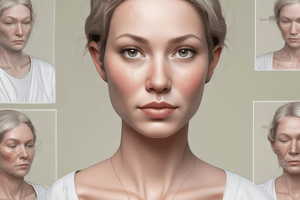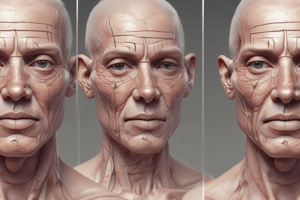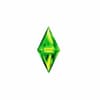Podcast
Questions and Answers
Explain the surgical significance of the internal acoustic meatus. What anatomical considerations are crucial during surgical procedures involving the inner ear?
Explain the surgical significance of the internal acoustic meatus. What anatomical considerations are crucial during surgical procedures involving the inner ear?
The internal acoustic meatus houses the facial nerve and vestibulocochlear nerve. Any surgical intervention in this region must be performed with extreme caution due to the proximity of these crucial nerves. Anatomical considerations include the delicate bony labyrinth, the narrowness of the meatus, and the intricate vascular network surrounding the inner ear.
Outline the steps involved in a cochlear implant procedure from an anatomical perspective.
Outline the steps involved in a cochlear implant procedure from an anatomical perspective.
A cochlear implant procedure involves several anatomical steps starting with a mastoidectomy to expose the temporal bone. This is followed by drilling a small hole into the bone surrounding the cochlea. A thin electrode array is then carefully inserted into the cochlea, bypassing the damaged inner ear structures. The external portion of the implant, which includes a microphone and speech processor, is secured behind the ear, connecting to the internal device via a magnet.
Describe the danger spaces of the neck and their relevance in surgical procedures.
Describe the danger spaces of the neck and their relevance in surgical procedures.
The danger spaces of the neck are potential areas for the spread of infection due to the loose connective tissue within. The most significant are the retropharyngeal space, the prevertebral space, and the carotid sheath. Surgical procedures in the neck must carefully consider these spaces to prevent potential complications.
State the boundaries and significance of the posterior triangle of the neck. What are the key contents of this region, and how do they relate to surgical interventions?
State the boundaries and significance of the posterior triangle of the neck. What are the key contents of this region, and how do they relate to surgical interventions?
Describe the anatomical boundaries of the lymph node levels of the neck and explain the surgical relevance of this regionalization.
Describe the anatomical boundaries of the lymph node levels of the neck and explain the surgical relevance of this regionalization.
Explain the anatomical basis of Erb's point and its clinical significance in neck dissections.
Explain the anatomical basis of Erb's point and its clinical significance in neck dissections.
What are the boundaries and surgical relevance of the suboccipital triangle?
What are the boundaries and surgical relevance of the suboccipital triangle?
Describe the relationship of the recurrent laryngeal nerve to Berry's ligament and explain its surgical significance.
Describe the relationship of the recurrent laryngeal nerve to Berry's ligament and explain its surgical significance.
Describe the course and branches of the facial nerve, starting from its exit from the brainstem and ending at its entry into the parotid gland.
Describe the course and branches of the facial nerve, starting from its exit from the brainstem and ending at its entry into the parotid gland.
Compare and contrast the anatomical basis and clinical presentation of upper and lower motor neuron facial palsies.
Compare and contrast the anatomical basis and clinical presentation of upper and lower motor neuron facial palsies.
Describe the sensory innervation of the temporomandibular joint (TMJ). What sensory pathways are involved in transmitting pain and proprioception from the TMJ?
Describe the sensory innervation of the temporomandibular joint (TMJ). What sensory pathways are involved in transmitting pain and proprioception from the TMJ?
Explain the concept of 'gustatory sweating' and its anatomical basis.
Explain the concept of 'gustatory sweating' and its anatomical basis.
What are the neurovascular structures found within the parotid gland, from superficial to deep?
What are the neurovascular structures found within the parotid gland, from superficial to deep?
Describe the anatomical basis and significance of the 'danger area' of the face.
Describe the anatomical basis and significance of the 'danger area' of the face.
Explain the anatomical basis for the profuse bleeding and rapid healing observed with facial cut wounds.
Explain the anatomical basis for the profuse bleeding and rapid healing observed with facial cut wounds.
Describe the superficial musculoaponeurotic system (SMAS) in the face, including its surgical relevance.
Describe the superficial musculoaponeurotic system (SMAS) in the face, including its surgical relevance.
What are the anatomical structures that could be damaged during a thyroidectomy leading to hoarseness of the voice?
What are the anatomical structures that could be damaged during a thyroidectomy leading to hoarseness of the voice?
Explain the anatomical basis for the reduced pitch of voice after thyroidectomy.
Explain the anatomical basis for the reduced pitch of voice after thyroidectomy.
What is the typical number and position of the parathyroid glands, and what are two possible ectopic locations?
What is the typical number and position of the parathyroid glands, and what are two possible ectopic locations?
What is the embryologic basis of common neck masses, specifically those arising from the pharyngeal apparatus?
What is the embryologic basis of common neck masses, specifically those arising from the pharyngeal apparatus?
What is the innervation of the carotid body and carotid sinus, and what are their respective functions?
What is the innervation of the carotid body and carotid sinus, and what are their respective functions?
Describe the boundaries and surgical relevance of Farabeuf's triangle.
Describe the boundaries and surgical relevance of Farabeuf's triangle.
Describe the origin, extents, relations, and surgical significance of the common carotid artery.
Describe the origin, extents, relations, and surgical significance of the common carotid artery.
Explain the anatomical basis for the clinical manifestations of a lesion affecting the cervical part of the vagus nerve.
Explain the anatomical basis for the clinical manifestations of a lesion affecting the cervical part of the vagus nerve.
Flashcards
Internal Acoustic Meatus
Internal Acoustic Meatus
A canal in the skull that transmits nerves related to hearing and balance.
Cochlear Implant Steps
Cochlear Implant Steps
A surgical procedure involving accessing the inner ear and placing an electronic device.
Erb’s Point
Erb’s Point
A point in the neck where several nerves emerge, often used in neck dissection.
Posterior Triangle
Posterior Triangle
Signup and view all the flashcards
Spinal Accessory Nerve Variation
Spinal Accessory Nerve Variation
Signup and view all the flashcards
Suboccipital Triangle
Suboccipital Triangle
Signup and view all the flashcards
Sternocleidomastoid Blood Supply
Sternocleidomastoid Blood Supply
Signup and view all the flashcards
Congenital Torticollis
Congenital Torticollis
Signup and view all the flashcards
Complications of thyroidectomy
Complications of thyroidectomy
Signup and view all the flashcards
Parathyroid glands
Parathyroid glands
Signup and view all the flashcards
Ectopic sites of parathyroid glands
Ectopic sites of parathyroid glands
Signup and view all the flashcards
Carotid body function
Carotid body function
Signup and view all the flashcards
Common carotid artery
Common carotid artery
Signup and view all the flashcards
Cricothyrotomy vs Tracheostomy
Cricothyrotomy vs Tracheostomy
Signup and view all the flashcards
Infratemporal fossa boundaries
Infratemporal fossa boundaries
Signup and view all the flashcards
Temporomandibular joint
Temporomandibular joint
Signup and view all the flashcards
Superficial Musculoaponeurotic System (SMAS)
Superficial Musculoaponeurotic System (SMAS)
Signup and view all the flashcards
Facial artery tortuosity
Facial artery tortuosity
Signup and view all the flashcards
Facial cut wounds
Facial cut wounds
Signup and view all the flashcards
Danger area of the face
Danger area of the face
Signup and view all the flashcards
Parotid gland innervation
Parotid gland innervation
Signup and view all the flashcards
Upper vs lower motor neuron facial palsies
Upper vs lower motor neuron facial palsies
Signup and view all the flashcards
Lacrimation pathway
Lacrimation pathway
Signup and view all the flashcards
Facial nerve course
Facial nerve course
Signup and view all the flashcards
Study Notes
Chapter 1: The Face, Parotid Region, and Extracranial Facial Nerve
- Describe the Superficial Musculoaponeurotic System (SMAS) and its surgical relevance.
- Illustrate tension lines of facial skin with a diagram.
- Detail regional differences in facial layers and their surgical importance.
- Explain why the facial artery is tortuous and why facial cuts bleed profusely but heal faster.
- Diagram the facial artery and its branches.
- Illustrate venous drainage of the face with a labeled diagram.
- Define the "danger area" of the face and its anatomical basis.
- Illustrate the drainage areas of submental, submandibular, and pre-auricular lymph nodes.
- Diagram anatomical landmarks for nerve blocks (mental, infraorbital, supraorbital).
- Describe sensory pathways for touch and vibration sensations from the inferior lip and temporomandibular joint.
- Identify structures that constitute the parotid bed.
- Describe parotid gland innervation (sensory, secretomotor, vasomotor). Outline facial nerve anatomy, including brainstem nuclei, and their function. Include the course and branches of its segments (intracranial, meatal, labyrinthine, tympanic, mastoid, extratemporal).
- Explain supranuclear control and basis for upper/lower motor neuron facial palsies.
- Describe lacrimation pathway and anatomical basis for gustatory sweating.
- Identify the muscle surrounding the orbit, including its arterial supply, venous drainage, and lymphatic drainage.
- Detail sensory innervation to the upper eyelid.
- Describe the muscles that control the oral sphincter and their nerve supply.
- State motor supply to facial expression muscles.
- List the nerves supplying the forehead.
- Identify the structures surrounding the parotid gland.
- Detail structures emerging from the parotid gland.
- Explain the arterial supply and venous drainage of the parotid gland.
- Outline neurovascular structures from superficial to deep within the parotid gland.
- Define gustatory sweating.
- Detail the facial nerve's course through the foramen to the parotid gland.
Chapter 2: Orbit and Eyeball
- Describe the margins and walls of the orbit.
- Name structures that communicate with the orbit
- State the relations of the orbit.
- Name the bones that form the orbital wall.
- Explain Superior Orbital syndrome.
- Describe likely complications of orbital floor blow-out fractures.
- Detail optic nerve components, coverings, blood supply, and clinical significance.
- State attachments, innervation, and actions of extraocular muscles.
- Describe oculomotor, trochlear, and abducens nerves.
Chapter 3: Temporal Bone and Ear
- State the surgical significance of the Pterion.
- Review temporal bone surface anatomy and its surgical significance.
- Discuss surgical implications of temporal bone anatomy.
- Describe anatomical considerations for approaches to the temporal fossa.
- State the clinical significance of the temporal fossa.
- List some external ear conditions.
- Describe the anatomical basis of the human auricle's various shapes.
- Discuss anatomical considerations for external ear surgery.
- Illustrate auricle innervation (lateral and posterior views).
- State the anatomical basis for external ear surgery complications.
- Discuss the surgical relevance of the external ear's blood supply.
- Explain the anatomical basis for surgical options for external ear conditions.
- Outline the boundaries of the tympanic cavity on an open skull.
- Detail the surgical significance of the tympanic walls.
- Discuss the anatomical basis of clinical signs and symptoms of some middle ear conditions.
- Explain the anatomical basis for applying the tuning fork to test for hearing loss.
- Detail anatomical considerations for surgical approaches to the middle ear.
- List steps for a simple mastoidectomy.
- State the anatomical basis for surgical options in middle ear conditions.
- Describe the surgical relevance of the internal acoustic meatus.
- Discuss anatomical considerations for inner ear surgery.
Chapter 4: Posterior Neck Triangles and Suboccipital Triangle
- Describe the organization of the fascial layers of the neck at C7 level with labeled diagram.
- Describe the "danger spaces" of the neck.
- Describe the attachments, structures enclosed, and clinical significance of the investing fascia.
- Discuss blood supply to the sternocleidomastoid and trapezius muscles and their surgical significance.
- Define Erb's point and its anatomical basis and utility in neck dissection.
- State boundaries, contents, and clinical significance of the posterior triangle.
- Describe neck lymphatic drainage and its clinical significance.
- Describe anatomical variations of the spinal accessory nerve.
Chapter 5: Infrahyoid Anterior Neck Triangles
- Describe the anatomical position, parts, and muscular & ligamentous attachments of the hyoid bone.
- State the anatomical basis of congenital torticollis.
- State the cutaneous innervation of the anterior neck's skin.
- State the components, attachments, innervation, and actions of the "strap muscles".
- Describe the thyroid gland's position, relations, and blood supply.
- Describe Zuckerkandl tubercles and surgical significance.
- State the origin, course, and distribution of the recurrent laryngeal nerve.
- State the anatomical basis for thyroidectomy complications (hoarseness, reduced pitch, hypocalcemia).
- Describe the normal number and position of parathyroid glands.
- Discuss the pharyngeal apparatus and common neck masses' embryologic basis.
- Describe the innervation and function of carotid body and sinus.
- Describe anatomical boundaries and surgical relevance of the FARABEUF's triangle.
- Describe the origin, extents, relations, and surgical significance of the common carotid artery.
- Describe the origin, course, termination, branches, and variations in the origins of the external carotid artery.
- Describe the formation, tributaries, and termination of the internal jugular vein.
- Describe the extent, course, relations, and distribution of the cervical vagus nerve.
- Detail the functional components of the cervical vagus nerve.
- Describe the surgical considerations of cricothyroidotomy and tracheostomy.
- Describe the formation and distribution of the ansa cervicalis with a well-labeled diagram.
- Describe surface landmarks for the cervical vertebrae.
Chapter 6: Temporal, Infratemporal, and Submandibular Regions
- State maxillary artery origin, course, parts, distribution, and surgical relevance.
- Outline pterygopalatine fossa boundaries, contents, and surgical significance.
- Detail temporomandibular joint articulating surfaces, stability factors, relations, blood supply, and innervation.
- Describe the insertion, innervation, and relations of the posterior belly of the digastric muscle.
- Name components of the styloid apparatus.
- Outline submandibular gland position, parts, relations, and blood supply.
- Describe parasympathetic innervation to sublingual and submandibular glands.
- State the origin, course, and distribution of the hypoglossal nerve.
- Describe submandibular and submental lymph node drainage and clinical significance.
- Detail external carotid artery branches in the submandibular triangle.
- State possible complications of sublingual gland excision and their anatomical bases.
Chapter 7: Oral & Nasal Cavities
-
Review the relevant surface anatomy of the mandible for planning surgery.
-
State anatomical considerations for lip augmentation.
-
Discuss the surgical relevance/significance of the oral vestibule.
-
Review relevant anatomy of the oral cavity for surgical conditions.
-
State the anatomical basis of signs/symptoms for oral cavity conditions.
-
Explain the anatomical basis for choosing diagnostic tests/investigations for oral cavity conditions.
-
List anatomical considerations for oral cavity surgical approaches.
-
Explain anatomical basis for oral cavity surgical options.
-
List anatomical steps for oral cavity surgical procedures.
-
State the anatomical basis for oral cavity surgical complications.
-
Revise venous drainage of the nose and its clinical significance.
-
Review lymphatic drainage and lymph node groups of the face and scalp.
-
Review the relevant anatomy of the external nose for surgical procedures.
-
State the anatomical basis of signs/symptoms in external nose conditions.
-
Explain the anatomical basis for choosing diagnostic tests/investigations in external nose conditions.
-
List anatomical considerations for nasal reconstruction procedures.
-
Explain anatomical basis for surgical options in external nose procedures.
-
List anatomical steps for rhinoplasty.
-
State the anatomical basis for external nose surgical complications.
-
Study features of each meatus on a hemi-face section with turbinates
-
Review the relevant anatomy of the nasal cavity for nasal conditions.
-
State the anatomical basis of signs/symptoms in nasal conditions.
-
Explain anatomical basis for choosing diagnostic tests for nasal conditions.
-
List anatomical considerations for nasal cavity approaches.
-
Explain anatomical basis for surgical options in nasal turbinate surgery.
-
List anatomical steps for septoplasty.
-
State the anatomical basis for nasal cavity surgical complications.
-
Review paranasal sinuses' anatomy in relation to surgery.
-
State the anatomical basis of signs/symptoms in paranasal sinus conditions.
-
Explain the anatomical basis for choosing diagnostic tests for paranasal sinuses.
-
List anatomical considerations for paranasal sinus approaches.
-
Explain the anatomical basis for surgical options in paranasal sinus surgery.
-
List anatomical steps for functional endoscopic sinus surgery.
-
State the anatomical basis for FESS complications.
-
Review the external and internal carotid arteries.
Studying That Suits You
Use AI to generate personalized quizzes and flashcards to suit your learning preferences.





